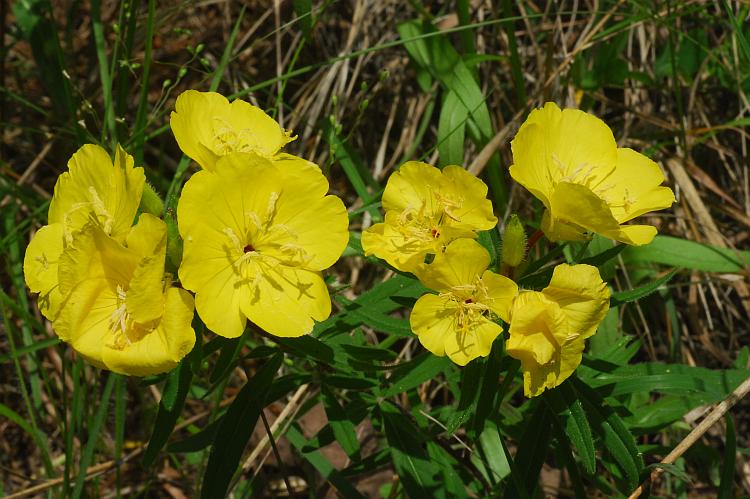Oenothera fruticosa L.
Sundrops

Native
CC = Amb
CW = Amb
MOC = 6
© SRTurner
Oenothera fruticosa L.Sundrops | |
 |
Native CC = Amb CW = Amb MOC = 6 |
© SRTurner |
|
Family - Onagraceae Habit - Perennial forb with fibrous and sometimes thickened roots. Stems - Ascending to erect, solitary or a few, to 80 cm, branched or unbranched, glabrous to densely pubescent with short glandular or nonglandular hairs.
Leaves - Basal and alternate, simple. Basal leaves overwintering and often withered at flowering; rosette leaves 3-12 cm long, 5-30 mm wide, oblanceolate to obovate, short- or occasionally longer-petiolate, the margins entire to slightly irregular or wavy or the broader ones with a few coarse teeth, hairy, the surfaces glabrous to densely hairy; stem leaves 2-6 cm long, 2-20 mm wide, very narrowly elliptic to broadly ovate, mostly short-petiolate, the margins entire to slightly irregular or wavy or the broader ones with a few coarse teeth, hairy, the surfaces glabrous to densely nonglandular and/or glandular-hairy, the secondary veins inconspicuous or (on broader leaves) moderately conspicuous.
Inflorescences - Open spikes, not grouped into panicles, usually relatively short and sometimes few-flowered, the portion in bud erect or rarely nodding, the axis glabrous to densely pubescent with short, nonglandular and/or glandular hairs. Bracts relatively conspicuous, 5-40 mm long, 1-10 mm wide, linear to lanceolate. Flowers - Actinomorphic, opening in the morning, the floral tube 5-20 mm long, short-hairy. Sepals 5-20 mm long, with short, spreading, glandular or nonglandular hairs, the free tips in bud 0.5-1.0 mm long, erect and appressed or somewhat spreading. Petals 15-30 mm long, 10-30 mm wide, broadly obovate to broadly oblong-obovate (truncate to shallowly and broadly notched and sometimes somewhat undulate at the tip), lacking a stalklike base, light yellow to deep yellow, fading to yellow or lavender. Stamens with the filaments 5-15 mm long, ascending, glabrous at the base, the anthers 4-7 mm long, yellow. Style 12-20 mm long, the stigma positioned well above the anthers, deeply 4-lobed, the lobes 3-5 mm long.
Fruits - Capsules 12-19 mm long, 3-4 mm in diameter, the main body longitudinally dehiscent toward the tip and eventually more or less the entire length, 4-locular, club-shaped or oblong in outline, not flattened, strongly 4-angled or 4-winged, the surfaces glabrous or finely glandular- or nonglandular-hairy, gradually or abruptly tapered to a sterile, stalklike base 1-10 mm long, this also glabrous or hairy. Seeds numerous in each locule, clustered and not in definite rows, 0.8-1.0 mm long, 0.3-0.5 mm wide, irregularly rhombic-ellipsoid to prismatic-ovoid, the surface dark reddish brown, pebbled. Flowering - June - October. Habitat - Openings in upland forests. Origin - Native to the U.S. Lookalikes - Several other species of Oenothera. Other info. - This attractive species is uncommon in Missouri, so far reported from only six counties in the southern and western regions of the state. The U.S. distribution is largely eastern and southeastern, with Missouri lying at the northwestern extent of its natural range. Species of Oenothera can be difficult to key, with aspects of fruit morphology usually required for confident determination. Characters pointing to this species include narrow leaves and large yellow flowers. Photographs taken in Hot Spring County, AR, 5-6-2015, and in the Ouachita National Forest, Montgomery County, AR, (SRTurner). |